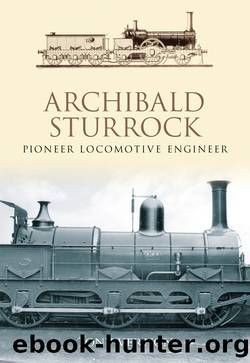Archibald Sturrock by Tony Vernon

Author:Tony Vernon
Language: eng
Format: epub
ISBN: 9780752472102
Publisher: The History Press
Published: 2011-11-02T00:00:00+00:00
Eastern Counties
0.72
South Eastern
1.00
Midland
1.05
London & Brighton
1.15
London North Western
1,39
Great Western
1.60
North Eastern
2.72
Norht British
2.75
Great Northern
3.22
By the next Board at the end of May 1857 Clarke reported that the quantity of grease used in early 1857 had declined markedly by comparison with the same period in 1856. Consumption had fallen from 161 tons 13cwt to 82 tons 8cwt. GNR figures now looked reasonable and Sturrock might have thought he could relax. However, Clarke produced another report in early 1858 to show that GNR consumption in the second half of 1857 was again more than double the average for seven railways. The London & Brighton was the most economical, consuming 0.927 tons per train mile and the highest, apart from the GNR, was the North Eastern at 1.702 tons per mile in the half year. The GNR had consumed 4.070 tons per mile! Sturrock argued that the high consumption was due to high speeds and heat and the fact that the additional plant at Doncaster had been delivered late. The Board were reminded that there had been no carriages or trains taken off due to overheating. The issue was discussed at the accounts committee, which noted the GNR consumed 222 tons more than the LNWR, 218 tons more than the Midland and 248 tons more than the North Eastern. In March 1858 Sturrock obtained Board approval to try some grease from James Lawrie, who promised to save a third of current costs. In June black grease was tried from another supplier, but found inferior to GNR grease. The grease caught fire and burnt the man carrying out the experiment. Lawrieâs grease did not achieve the savings promised.
During June 1857 Seymour Clarke identified a need for more carriages and suggested Sturrockâs team should build twenty first-class carriages, including some with second-class compartments, plus six one-horse and twelve two-horse vans. The Doncaster shops had already built over twenty road goods vans, but had not previously built any first-class carriages. The only passenger vehicle constructed at Doncaster had been the composite invalid carriage completed in 1854 and eight passenger luggage vans. Sturrock noted at a subsequent Board that progress was slow as he was having difficulty getting supplies of timber from the stores department. Meanwhile Seymour Clarke had seen the quality of the carriages the LNWR was using for its Manchester service and suggested Sturrock had a look at some carriages that Williams had available. Sturrock mistook Clarkeâs message for an instruction to buy and arranged for GNR axles and lace to be installed in Williamsâ carriages. Clarke reported to the Board, âNo doubt Sturrock was activated by a desire to obtain stock when it was really wanted and that he no doubt thought he was justified in the steps he took.â At the Board on 17 October 1857, agreement was given to buy nine carriages from Williams. Six first-class carriages cost £325 each and three composites £290 each. These replaced some of those to be built in Sturrockâs carriage shops, which produced three first-class carriages between December 1857 and February 1858.
Download
This site does not store any files on its server. We only index and link to content provided by other sites. Please contact the content providers to delete copyright contents if any and email us, we'll remove relevant links or contents immediately.
| Military | Political |
| Presidents & Heads of State | Religious |
| Rich & Famous | Royalty |
| Social Activists |
Waking Up in Heaven: A True Story of Brokenness, Heaven, and Life Again by McVea Crystal & Tresniowski Alex(37615)
Empire of the Sikhs by Patwant Singh(22907)
We're Going to Need More Wine by Gabrielle Union(18906)
Hans Sturm: A Soldier's Odyssey on the Eastern Front by Gordon Williamson(18431)
Leonardo da Vinci by Walter Isaacson(13107)
The Radium Girls by Kate Moore(11867)
Tools of Titans by Timothy Ferriss(8157)
Educated by Tara Westover(7883)
How to Be a Bawse: A Guide to Conquering Life by Lilly Singh(7344)
Permanent Record by Edward Snowden(5682)
The Last Black Unicorn by Tiffany Haddish(5525)
The Rise and Fall of Senator Joe McCarthy by James Cross Giblin(5171)
Promise Me, Dad by Joe Biden(5036)
The Wind in My Hair by Masih Alinejad(5009)
A Higher Loyalty: Truth, Lies, and Leadership by James Comey(4797)
The Crown by Robert Lacey(4690)
The Iron Duke by The Iron Duke(4253)
Joan of Arc by Mary Gordon(3981)
Stalin by Stephen Kotkin(3826)
